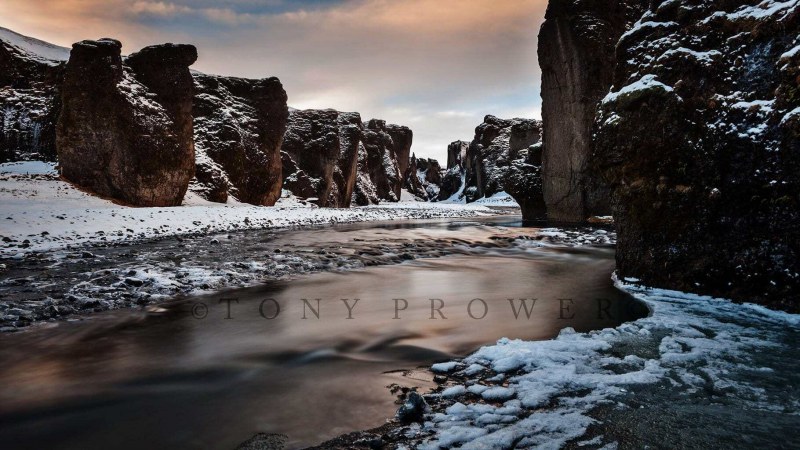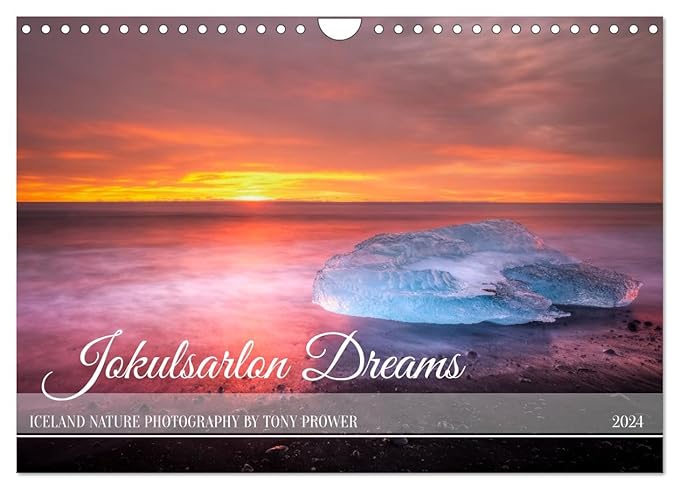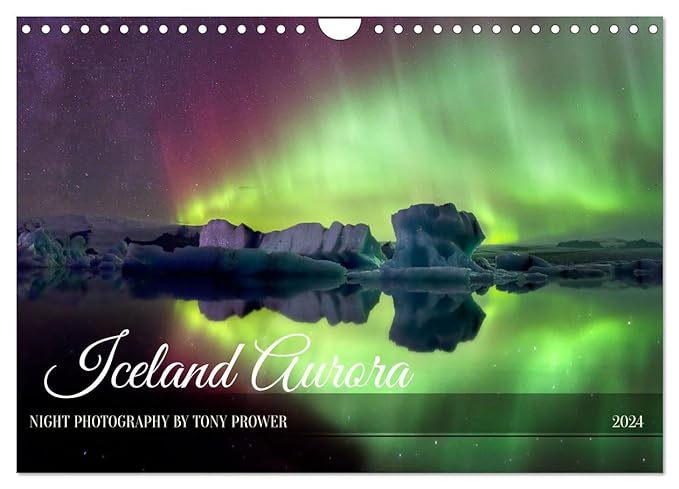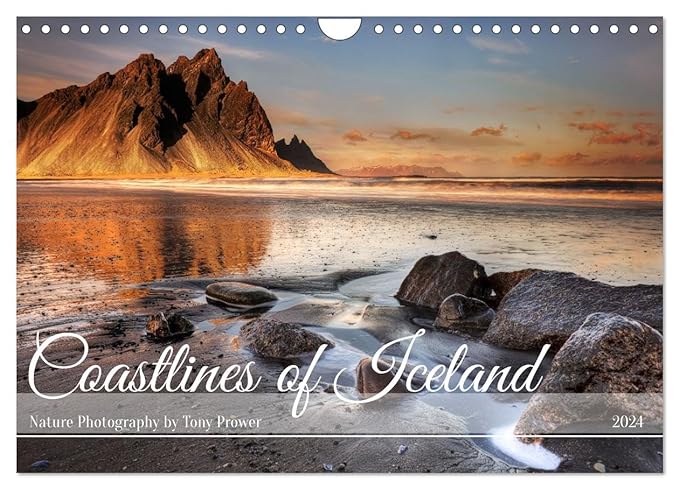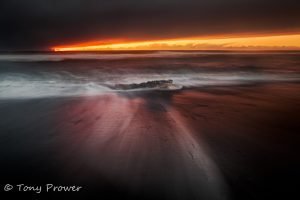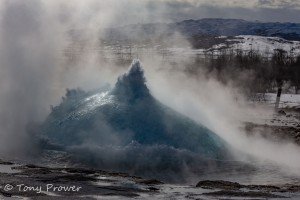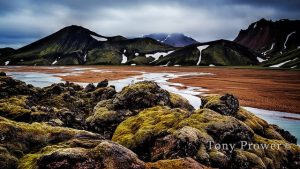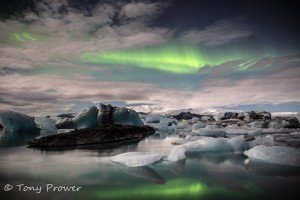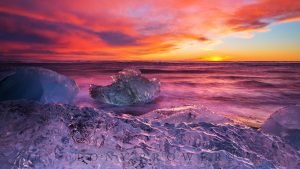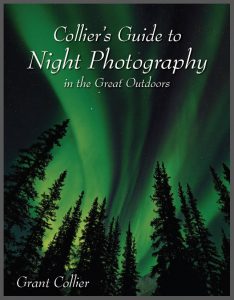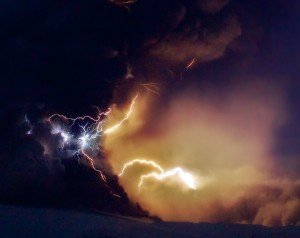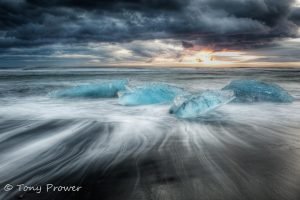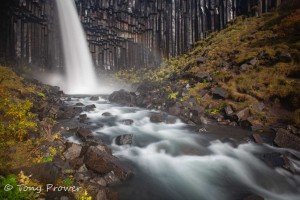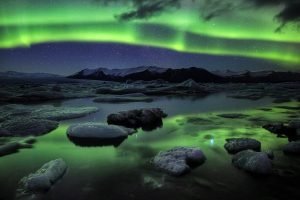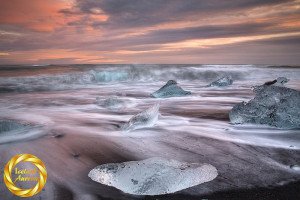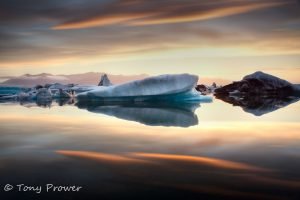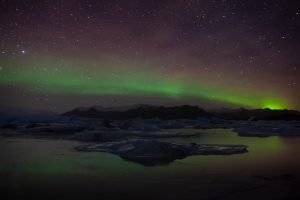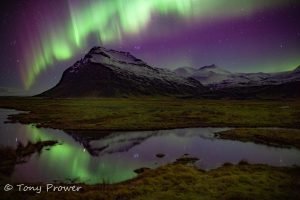Camera settings
- ƒ/9
- 24 mm
- 30 seconds
- 50
- Mode: AV mode with + 2 stops over (compensation +/-).
- Focus: f/8 hyperfocal mark. This is slightly weighted to the foreground.
Location:
This nature photo was taken on February 15, 2011 at the Fjaðrargljufur river canyon in South East Iceland. The unassuming river winds like a snake between the rocks. The canyon was forged over 6 million years and most of the forging force was when the river flashed asunder during volcanic eruptions under the Vatnjökull Glacier.
Fjaðrárgljúfur location guide.
Background Story
I love landscapes with water of any form. For me, the river completes the story of how the landscape was formed and also completes the holy trinity of landscapes; Land, Sky, Water. Water features in this scene in many ways. The snow on the canyon walls, the river winding through the gorge, the clouds in the sky and the ice in the foreground. There are interactions of the elements throughout the scene.
There is no special light entering the canyon, but because I am there for a sunset the colours in the clouds reflect in the water and lift the scene.
Composition
To compose this photograph, I wanted to get as close to the river as possible. There is a lot of ice on the ground, so there is a danger of sliding into the river if I get too close. I am paying particular attention to the bottom of the scene and I am careful to include the foreground ice with a decent shape and proportion. I want the line coming past the half way point of the bottom of the frame. I want the foreground ice to be meaningful.
Tripod Height
It might be tempting to get lower and get more intimate detail on the foreground ice and even include more sky, but I had learnt from the past that getting low sacrifices the middle ground and would have destroyed the shape of the river coming through the canyon. My tripod is set up at chest height and you can just see the river disappearing into the canyon.
Focal length
The top half was problematic because I tried to include the whole of the 2nd rock wall on the right, but doing this sacrificed too much foreground, leaving no shape whatsoever. The compromise was to cut it in half which gives a slightly claustrophobic feel. I was able to include enough snow on the first rock wall to prevent it being too claustrophobic.
I am using my 24mm prime lens. As I mentioned, this was a little restrictive regarding the height of the canyon walls and my position. A wider focal length might have been able to include the tops of the closer rock walls, but I would have lost detail further down the canyon.
Aperture
F/9 was a suitable aperture because my tripod was set up at chest high so it wasn’t very close to the foreground. I am able to get front to back sharpness at f/9 with this composition.
Magic Cloth
Long exposure = 30 seconds.
During this 30 second exposure, the sky had to be covered after just 3 seconds to preserve the rich colours. I also had to be careful not to expose the bottom half for the remaining 30 seconds because I didn’t want to loose the colour in the river. I was attempting to use the cloth to give extra exposure to the canyon walls.
When the shutter opened, I allowed a couple of seconds on the sky and then covered the whole scene. Using systematic angles to match the rocks I carefully lifted the cloth a couple of times with a high left diagonal and then with a high right diagonal. I used a horizontal cloth carefully on the right on the scene. All these diagonal cloth movement were also exposing the foreground ice and river, so after the diagonal action I covered the lens and waited for the exposure to end. The same result could ave been achieved with a 20 second exposure.
Snow on black rocks give the photographer quite a bit of exposure margin. In post processing just a bit of simple dodging and burning can give the desired result. Knowing this I was not too ambitious with the diagonal movements. I just used them to carefully boost the exposure to the high rock walls.
About the Magic Cloth Technique
The Magic Cloth Technique includes controlling the level of exposure throughout a long exposure to various portions of a landscape photograph. The Magic Cloth technique attempts to get the image right in the camera but to capture the full range of a scene.
Alternative to Grads
Under ordinary circumstances, the top section of a landscape is lighter than the lower half. In order to get the best exposure of both the sky and the land, graduated filters have been used by photographers. These filter are dark at the top and clear at the bottom. Grad filters come in various strengths that are measured in stops. Grads are soft or hard. Therefore, if you want graduated filters to cover every eventuality, you could end up with a packet of 6 filters plus a holding device and adapter. Afterward there are inverse grads to consider where the top half is dimmer, but gets slightly lighter towards the top. You are able to use a combination of angles if you have a Gorge scene.
ND (Neutral Density) Filters
The N D filter is use to lengthen the exposure without needing to wait for it to get dark. You can also achieve milky waterfalls or wave action. Like grad filters, they come in different strengths.South Iceland Tours
Equipment
Choose the right equipment for Long Exposure Magic cloth photography. A lens with a big element is desirable because it gives you a large area to move the cloth around. But you don’t want it too large that filters are difficult to use. Super wide lenses can create issues with the distortion. The horizon can become curved making it difficult to judge the cloth movements.
Canon full frame DSLRs are ideal for Long exposure landscape photography.
- Easy select shooting modes
- Great live view is able to fine focus stars!
- Most settings can be changed with thumb and forefinger .
- The Red light on the back tells you if you are shooting. (Good to have at night)
- Other cameras recommended for Low light photography – Nikon D850
